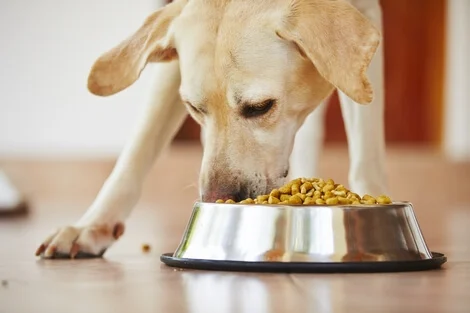
DogFoodAdvisor is reader supported See how
Dog Food Advisor is 100% impartial and is never paid to promote any brand. But if you buy using links on this page, we may earn a referral fee.
Believe it or not, the state of your dog’s feeding dish plays a crucial role in their overall health.
Think about it — how would you feel if your dinner plate went unwashed for days? It would become a breeding ground for harmful bacteria, potentially making you ill. The same principle applies to your furry friend.
In this article, you will discover the reasons why you should clean your pet’s bowl regularly and provide you with essential tips on effective maintenance.
Why is cleaning your dog’s bowl important?
The National Sanitation Foundation conducted a study that found that pet bowls were one of the top five dirtiest places in the home.
Bacteria such as salmonella and E. coli are commonly found in dog bowls. Plus, their watering bowls can accrue algae and mold if pet parents don’t take the time to clean them routinely.
Dirty bowls can also attract unwanted pests like ants and flies. These pests can contaminate your pet’s food and water, making them unsafe to consume.
Additionally, your dog’s oral hygiene might suffer as a result of drinking or eating from a dirty bowl, and it can even affect the skin around their mouth.
If these weren’t enough reasons to clean your dog’s bowl, then may we add that a filthy bowl can actually spread bacteria such as MRSA, salmonella, and E. coli to the people who handle the food and water bowls too.
What bowl is best for my dog?
Plastic bowls
Plastic bowls are the most difficult to maintain. They are prone to small nicks and scratches, in which bacteria can build up. If you do opt for a plastic bowl, clean them frequently and change them every few months.
Stainless steel bowls
Stainless steel bowls, renowned for their durability, also offer superior hygiene. Their smooth surface is easy to sanitize, making them a more hygienic choice when compared to plastic.
Ceramic bowls
Ceramic pet bowls, on the other hand, provide an excellent alternative. Their substantial weight prevents your dog from nudging them around and they keep your dog’s food and water cool on hot days. The protective glaze not only keeps them clean but also makes them dishwasher-safe, ensuring a consistently hygienic dining experience.
To avoid the daily chore of frequent cleaning, it’s a practical idea to have multiple bowls that you can rotate. This way, your furry friend won’t need to wait for you to clean their bowl before serving dinner.
How do I clean my dog’s bowl?
How to handwash your dog’s bowl
You might rinse your pet’s bowl every now and again under warm water, or wipe it with a damp cloth but unfortunately, that’s just not enough.
Fortunately, this isn’t the most difficult chore of being a pet parent (picking up poop or cleaning up accidents are surely worse).
To effectively hand wash your dog’s bowl, this should be done every day after their main meal (water bowls daily too) using your regular dish soap. Simply soak the bowl in warm, soapy water before using a sponge or brush to break any particles away.
You can then wipe the bowl with a clean, dry cloth and leave it to air dry for the remainder.
Disinfecting your dog’s bowl
Just because your dog’s bowl looks clean, doesn’t mean that it is germ-free. Washing your dogs’ dishes daily might not be enough to keep harmful bacteria away.
It is a good idea to completely disinfect both food and water bowls on a weekly basis. You can do so by using ½ cup of regular bleach with around a gallon of water, then steep the bowls for ten minutes before thoroughly rinsing with fresh water and drying.
Cleaning your dog’s bowl in the dishwasher
If you’re lucky enough to have a dishwasher, this can be an easy and effective way to kill the bacteria in your dog’s bowl.
Of course, using a dishwasher-safe bowl is a must and if you wash your dog’s bowl regularly, it is safe to wash them in the same load as your other dishes without concern of cross-contamination. However, washing your pet’s bowl among your favorite dinner plates may not sit right with you, and in this case, just run them through by themselves.
Make sure you use the highest heat setting, as some types of salmonella can withstand warm or tepid temperatures. For a double dose of disinfecting power, you can soak the dishes in a bleach and water solution for about ten minutes, then run them through the dishwasher on high heat.
Does the type of food affect how I clean my dog’s bowl?
Most dog foods will require the same level of cleaning, however, a raw diet will require a deeper clean after each use. Raw foods pose more of a risk for bacteria such as salmonella and E. coli, so these pet food dishes must be properly disinfected after every usage.
Additional hygiene tips
By this point, you likely understand the reasons and methods for washing your dog’s bowl. Here are some extra hygiene tips to consider for good measure.
A clean bowl won’t keep harmful bacteria away if the way your dog’s food is stored is unhygienic. Ensure you store their food in a safe dry place, and if you use storage containers, they will need to be cleaned regularly too.
It’s also important to change your dog’s water at least once a day as dogs actually contaminate their own drinking water when dipping their tongue into the dish.
You might want to invest in placemats if your pup is a messy eater. Placemats are great for keeping your pet’s bowls in place and maintaining their eating area, although they can also be a magnet for germs. Opt for a placemat that can be easily cleaned and ensure it is included in the regular cleaning regime.
FDA guidelines
Cleaning your pet’s bowl is deemed extremely important and the FDA also has some guidelines on the subject. Here are some additional tips to keep in mind:
- Wash pet food bowls and scooping utensils with soap and hot water after each use.
- Do not use your pet’s food bowl as a scooping utensil. Use a clean scoop, spoon, or cup instead. Use the scooping utensil only for scooping pet food.
- Throw out old or spoiled pet food in a safe way, for example, by placing it in a securely tied plastic bag in a covered trash can.
Final word
The Dog Food Advisor does not accept money, gifts, samples or other incentives in exchange for special consideration in preparing our reviews.
However, we do receive a referral fee from online retailers (like Chewy or Amazon) and from sellers of perishable pet food when readers click over to their websites from ours. This helps cover the cost of operation of our free blog. Thanks for your support.
For more information, please visit our Disclaimer and Disclosure page.
Article reviewed by
Laura Ward
Pet Nutritionist
Laura studied BSc (Hons) Animal Science with an accreditation in Nutrition at the University of Nottingham, before working for eight years in the pet food and nutrition industry.




